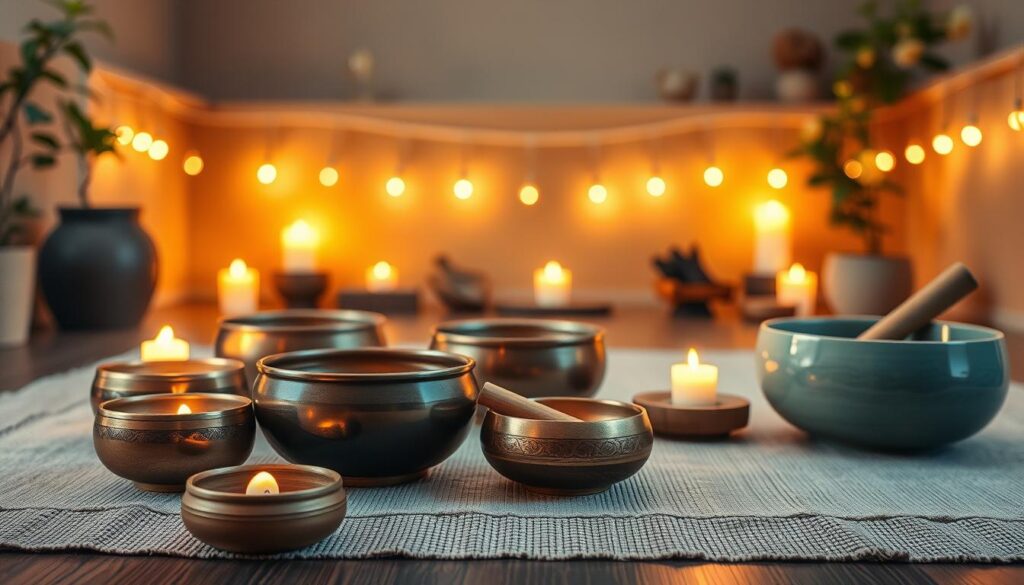I still remember the first time I tried meditation – it was a chaotic day, and I was looking for a way to calm my mind. As I sat quietly, focusing on my breath, I felt a sense of peace wash over me. That moment sparked a journey into the world of meditation practices, and I’ve been exploring its diverse approaches ever since.
As I’ve discovered, there’s more to meditation than just one technique. From mindfulness exercises to guided visualizations, the different styles offer unique benefits and cater to various needs. Whether you’re a busy professional seeking stress relief or simply looking to enhance your overall well-being, there’s a meditation practice out there for you.
By exploring the diverse world of meditation, you can find the right approach to suit your lifestyle and goals. This comprehensive guide will help you understand the different techniques, their benefits, and how to incorporate them into your daily routine.
Key Takeaways
- Discover the various meditation techniques and their unique benefits
- Learn how to choose the right meditation style for your needs and lifestyle
- Understand how meditation can enhance your mindfulness journey
- Explore the different approaches to meditation, from stress reduction to spiritual growth
- Find practical guidance on incorporating meditation into your daily routine
Understanding Meditation and Types
Meditation, a practice with roots in ancient traditions, has evolved into various forms, each with its unique benefits and focus areas. As we explore this practice, we’ll delve into its fundamental concept and the different types that have emerged over time.
What Is Meditation?
Meditation is a practice that involves focusing or clearing your mind using a combination of mental and physical techniques. Depending on the type of meditation you choose, you can meditate to relax, reduce anxiety and stress, and more. Some people even use meditation to help them improve their health, such as using it to help adapt to the challenges of quitting tobacco products.
The practice of meditation is thousands of years old, and different forms come from around the world. This ancient practice has been shaped by various cultures and traditions, resulting in a diverse range of meditation types.
The Science Behind Meditation
Modern science has only started studying this practice in detail during the last few decades. Some of the biggest leaps in science’s understanding of meditation have only been possible thanks to modern technology, such as EEG and fMRI scans. These technologies have allowed researchers to study the impacts of meditation on the brain and body, revealing measurable changes in brain structure and function.
Research has shown that regular meditation practice can lead to increased density in areas controlling attention, sensory processing, and emotional regulation. Moreover, regular meditation practice creates stronger neural connections that help maintain cognitive function as we age and enhance our ability to process difficult thoughts and emotions.
Let’s take a look at some key findings related to the science behind meditation:
| Study | Findings | Impact |
|---|---|---|
| EEG studies | Changes in brain wave patterns | Improved focus and relaxation |
| fMRI scans | Increased density in certain brain areas | Enhanced awareness and emotional regulation |
| Research on meditation and cognition | Improved cognitive function | Better maintenance of cognitive abilities with age |
As we can see from the table, the science behind meditation is vast and continues to grow as more research is conducted. Understanding the different types of meditation and their effects on our mind and body is crucial for making informed decisions about our practice.
Mindfulness Meditation: The Foundation Practice
If you’re new to meditation, you’ll likely start with mindfulness meditation, a practice that has been extensively studied for its health benefits.
Mindfulness meditation is a simple yet powerful practice that involves sitting quietly, breathing deeply, and observing your thoughts and feelings without judgment. As you practice mindfulness meditation, you’ll cultivate awareness of the present moment, allowing you to better manage stress and anxiety.
As a foundational practice, mindfulness meditation is an excellent starting point for those new to meditation. It is versatile and can be practiced solo or with a guided instructor. There is no specific time requirement, making it accessible to individuals with busy schedules.
How to Practice Mindfulness Meditation
To practice mindfulness meditation, start by finding a comfortable and quiet position. You can sit on a chair or on a cushion on the floor, whichever feels more natural to you. Begin by taking a few deep breaths, focusing on the sensation of the breath moving in and out of your body.
As you continue to breathe deeply, allow your attention to expand to other sensations in your body, such as the feeling of your feet on the ground or the sounds around you. When thoughts arise, simply acknowledge them and let them pass without engaging or judging them.
Start with short sessions, such as 5-10 minutes, and gradually increase the duration as you become more comfortable with the practice.
Benefits of Mindfulness Meditation
Research has shown that regular mindfulness meditation practice can have numerous benefits for both physical and mental health. Some of these benefits include reduced stress and anxiety, improved focus, and enhanced emotional regulation.
According to the National Institutes of Health, consistent mindfulness meditation practice has been found to lower high blood pressure, reduce chronic pain, and improve sleep quality. By incorporating mindfulness meditation into your daily routine, you can experience these benefits and improve your overall well-being.
By practicing mindfulness meditation, you can cultivate a greater sense of awareness and clarity, allowing you to navigate life’s challenges with more ease and confidence.
Focused Attention Meditation Techniques
Focused attention meditation techniques offer a powerful way to train your mind, enhancing concentration and reducing mind-wandering. These techniques are particularly helpful for individuals who struggle with scattered thoughts, as they emphasize concentration over open awareness.
Breath Meditation
Breath meditation involves using your breath as an anchor for your attention. By focusing on the natural rhythm of your breathing, you can achieve a deeper state of calm. To practice, sit comfortably, and bring your attention to your breath, noticing the sensation of the air entering and leaving your nostrils.
When your mind wanders, gently acknowledge the thought and return to your breath without judgment. Regular practice of breath meditation can lead to improved focus and reduced stress.
Visual-Based Meditation
Visual-based meditation involves focusing on a visual object, either with your eyes open or closed. This could be a candle flame, a mandala, or a mental image. The goal is to maintain your focus on the chosen object, cultivating awareness and concentration.
| Meditation Technique | Focus | Benefits |
|---|---|---|
| Breath Meditation | Natural rhythm of breathing | Improved focus, reduced stress |
| Visual-Based Meditation | Visual object (external or internal) | Cultivates awareness, enhances concentration |
Both breath and visual-based meditation techniques are effective ways to enhance your meditation practice, offering tools to improve attention and achieve a calmer mind.
Mantra Meditation: Using Sound and Words

Discover the power of mantra meditation, a simple yet effective technique that uses repetitive sounds or words to calm the mind and soothe the body. Mantra meditation is a form of meditation that involves repeating a single word, phrase, or sound to clear your mind of stress and clutter, promoting deeper levels of calm and body awareness.
This technique is particularly helpful if you find your mind wandering during other forms of meditation. By giving you something specific to focus on, mantra meditation prevents your mind from drifting to other thoughts and to-dos. It’s also one of the easiest forms of meditation to adopt and practice, as the repetition of the mantra is the only requirement.
How to Practice Mantra Meditation
To start practicing mantra meditation, choose a comfortable position, either sitting or lying down, and select a mantra that resonates with you. It could be a traditional Sanskrit phrase or a simple affirmation that aligns with your personal goals. Begin by repeating your chosen mantra, either out loud or to yourself, and focus on the sound. When your mind wanders, gently bring your attention back to the mantra.
The beauty of mantra meditation lies in its simplicity and flexibility. You can practice it anywhere, at any time, making it an ideal tool for managing stress and anxiety in today’s fast-paced world.
Popular Mantras and Their Meanings
There are numerous mantras to choose from, each with its own meaning and benefits. For example, the mantra “Om Mani Padme Hum” is believed to bring peace and compassion, while “So Hum” is thought to promote a sense of calm and connection to the universe. You can choose a mantra based on its meaning or simply because it feels right to you.
Experimenting with different mantras can help you find what works best for your personal practice. Whether you’re looking to reduce stress, improve your focus, or enhance your overall well-being, there’s a mantra that can support your goals.
Transcendental Meditation (TM)

Developed over 50 years ago, Transcendental Meditation has become a popular and scientifically-backed meditation practice. This technique, rooted in ancient traditions, has been widely adopted for its effectiveness in reducing stress and promoting overall well-being.
The TM Technique and Process
The TM technique is taught through four one-on-one sessions with a certified teacher, who provides a personalized mantra. To practice TM effectively, one must meditate twice a day for 20 minutes, allowing the mind to settle into a deeper state of consciousness. This form of meditation is designed to be effortless, promoting a state of calm and self-awareness.
Scientific Research on TM Benefits
Numerous studies have investigated the benefits of TM, finding significant reductions in stress and anxiety, as well as improvements in brain function and cardiovascular health. Research published in the Journal of the American Medical Association and Brain and Cognition has shown that TM can lead to physical changes in the brain, enhancing emotional regulation and reducing chronic stress. By incorporating TM into their daily practice, individuals can experience these benefits firsthand, leading to a more balanced and healthy life.
Loving-Kindness Meditation
As we explore loving-kindness meditation, we discover a simple yet profound way to cultivate love, kindness, and compassion in our daily lives. This heart-centered practice is designed to foster a sense of well-wishing towards ourselves and others, promoting a more harmonious and empathetic relationship with the world around us.

Cultivating Compassion Through Meditation
Loving-kindness meditation, or metta meditation, is rooted in the Buddhist tradition and is aimed at cultivating compassion for ourselves and others. By repeating positive and affirming phrases, we can shift our perspective from one of fear and inadequacy to one of love and understanding. Research has shown that this practice can enhance well-being, reduce self-criticism, and improve resilience.
For instance, a study conducted by researchers at the University of California, San Francisco, found that participants who practiced loving-kindness meditation for six weeks reported fewer emotional ups and downs in their social interactions, leading to greater overall connectivity with their community. You can explore more about the benefits and practices of loving-kindness meditation on resources like Mindful.org.
| Benefits | Description |
|---|---|
| Enhanced Well-being | Loving-kindness meditation promotes a positive outlook and overall well-being. |
| Reduced Self-Criticism | By fostering self-compassion, it helps in reducing self-criticism. |
| Improved Resilience | This practice helps in developing emotional resilience. |
Step-by-Step Loving-Kindness Practice
To practice loving-kindness meditation, start by finding a comfortable and quiet space where you can sit and relax. Begin by directing kindness towards yourself, repeating phrases such as “May I be happy, may I be healthy, may I be at peace.” Gradually expand your circle of kindness to include friends, neutral individuals, and even those you may have difficulty with.
As you continue this practice, you’ll find it becomes easier to cultivate feelings of empathy and understanding towards others. Remember, the goal is not to achieve a specific state but to cultivate a genuine sense of kindness and compassion.
Body-Centered Meditation Practices
Let’s take a closer look at body-centered meditation practices, which can help you reduce physical tension and mental stress.
Body-centered meditation is a form of meditation that focuses on physical sensations within the body. As Jon Kabat-Zinn, a renowned mindfulness expert, once said, “We are not our thoughts; we are the observers of our thoughts, and we can observe our bodily sensations with equal clarity”
“You can’t start living until you stop fighting the fact that you are alive”
though he was talking about general mindfulness, it underlines the importance of being aware of our bodily sensations.
These practices help strengthen the mind-body connection and develop embodied awareness. By focusing on the body, we can release tension, promote relaxation, and improve our overall well-being.
Body Scan Meditation
Body scan meditation is a technique that involves systematically moving your attention through different parts of your body, bringing awareness to each area, and releasing any tension you may find. To practice body scan meditation, start by lying or sitting comfortably, then bring your attention to different parts of your body, beginning from your toes and moving up to your head, or vice versa. As you focus on each area, try to release any tension or discomfort.
As Dan Siegel notes in his work on mindfulness, focusing on bodily sensations can have a profound impact on our mental state. You can also use a guided meditation recording to help guide you through the process.
Progressive Muscle Relaxation
Progressive muscle relaxation is another body-centered meditation technique that involves tensing and relaxing different muscle groups. Start by tensing a specific group of muscles, such as your fists or shoulders, and holding for a few seconds. Then, release the tension and feel the relaxation spread through the muscles.
Move through different muscle groups, tensing and relaxing as you go. This technique can help you become more aware of physical tension and release it, promoting deep relaxation and reducing stress.
Movement-Based Meditation
For many, the idea of meditation conjures images of sitting quietly, but movement can be a powerful catalyst for mindfulness. Mindfulness movement meditation is the process of using movement to help you make the connection between your mind and your body. Gentle movements such as yoga, walking, tai chi, and qi gong function as a conduit to achieving a meditative state, requiring just enough focus to silence all the mental noise.
Walking Meditation
Walking meditation transforms an everyday activity into a profound mindfulness practice by bringing full attention to each step and breath. To practice walking meditation, start by finding a quiet, peaceful place to walk. Pay attention to the sensation of your feet touching the ground, the movement of your legs, and the rhythm of your breathing. As you walk, let go of distractions and focus on the present moment.
Yoga as Meditation
Yoga evolved as a moving meditation practice, with specific postures (asanas) designed to prepare the body and mind for deeper meditation. Certain styles of yoga, such as Kundalini yoga, are aimed at strengthening the nervous system, helping you cope with everyday stress and problems. To gain the greatest benefit from yoga, it’s essential to take time for savasana or Shavasana, known as corpse or relaxation pose, to relax the body and relieve tension.
Tai Chi and Qigong
Tai Chi and Qigong are ancient Chinese practices that cultivate life energy (chi/qi) through slow, deliberate movements coordinated with breath. These meditative movement systems promote balance, flexibility, and inner peace. By focusing on the flow of movement and breath, you can quiet the mind and achieve a meditative state.
Movement-based meditation offers a versatile and accessible way to cultivate mindfulness, whether through formal practices like yoga or everyday activities like walking. By bringing awareness to your movements and breath, you can transform your daily experiences into opportunities for meditation.
Eastern Meditation Traditions
The ancient wisdom of Eastern meditation traditions continues to influence modern mindfulness practices, providing a foundation for inner peace and awareness. These timeless techniques have been refined over centuries, offering a wealth of methods for cultivating mindfulness, awareness, and inner transformation.
Zen Meditation
Zen meditation, also known as Zazen, is a practice of “just sitting” that cultivates present-moment awareness through upright posture, regulated breathing, and an attitude of non-striving. By focusing on the breath, particularly the sensation of the breath moving in and out of the belly, practitioners aim to foster a sense of presence and alertness. Zen meditation encourages a mindset of simplicity and clarity, allowing individuals to let go of distractions and cultivate a deeper understanding of themselves.
Vipassana Meditation
Vipassana, or insight meditation, is a systematic practice that involves intense self-observation and awareness of impermanence. This technique encourages practitioners to examine certain aspects of their existence with the intention of eventual transformation. By contemplating key areas such as suffering, unsatisfactoriness, impermanence, non-self, and emptiness, individuals can gain insight into the true nature of reality. Vipassana meditation is a powerful tool for developing clear seeing and understanding the nature of reality.
- Cultivates awareness of impermanence
- Encourages intense self-observation
- Fosters insight into the nature of reality
Chakra Meditation
Chakra meditation is an energy-based practice that focuses on keeping the body’s core chakras — centers of energy — open, aligned, and fluid. By working with these subtle energy centers, practitioners can promote physical, emotional, and spiritual balance. Blocked or imbalanced chakras can lead to discomfort, but chakra meditation helps to bring them back into balance, enhancing overall well-being.
These Eastern meditation traditions — Zen, Vipassana, and Chakra meditation — have been practiced for thousands of years and continue to influence contemporary mindfulness approaches. By adapting these traditional practices, modern practitioners can benefit from their transformative potential while maintaining their essential principles.
Sound and Sensory Meditation
Sound and sensory meditation offer a unique approach to achieving a meditative state, leveraging external stimuli to guide the mind. This form of meditation is particularly beneficial for beginners or those who struggle with traditional silent practices.

Sound Bath Meditation
Sound bath meditation is an immersive experience that utilizes instruments like singing bowls, gongs, and chimes to create sound vibrations. These vibrations help entrain brainwaves and induce a state of deep relaxation. By focusing on the sounds, individuals can quiet their minds and achieve a meditative state.
Guided Visualization Meditation
Guided visualization meditation is a powerful technique that uses imagination to create detailed mental scenarios. By visualizing peaceful scenes or images, individuals can reduce stress, enhance performance, and promote healing. This form of meditation engages multiple senses, making the experience more vivid and impactful.
The science behind these practices reveals that different sound frequencies can significantly affect brain activity, promoting relaxation and reducing anxiety. Similarly, visualization activates many of the same neural pathways as actual experiences, making it a potent tool for mental well-being.
To incorporate sound and sensory meditation into your daily routine, you can start by creating a simple sound meditation practice at home using readily available instruments or guided recordings. Resources for quality guided visualizations are also available online, catering to various purposes such as stress relief, improved focus, and enhanced creativity.
How to Choose the Right Meditation Type for You
When it comes to meditation, one size does not fit all – the key is finding the type that resonates with you. As we have explored various meditation types, it is essential to consider your goals, preferences, and personality to choose the most suitable one.
As Ross says, “There is no way to meditate incorrectly,” and your practice will welcome you back with zero judgment. This understanding gives us the freedom to explore different meditation styles without the pressure of doing it “right.”
Matching Meditation Styles to Your Goals
Different meditation types cater to different goals, such as stress reduction, improved focus, or emotional healing. For instance, if you are looking to reduce stress, you may find mindfulness meditation or body scan meditation beneficial. On the other hand, if you want to improve your focus, focused attention meditation or transcendental meditation might be more suitable.
| Meditation Type | Main Goal | Benefits |
|---|---|---|
| Mindfulness Meditation | Stress reduction | Reduce stress, improve emotional regulation |
| Focused Attention Meditation | Improve focus | Enhance concentration, improve mental clarity |
| Body Scan Meditation | Emotional healing | Promote relaxation, reduce physical tension |
Creating a Sustainable Meditation Practice
To create a sustainable meditation practice, it is crucial to start small, be consistent, and make it a habit. You can begin with short meditation sessions and gradually increase the duration as you get more comfortable with the practice. It is also essential to make meditation a part of your daily routine, such as right after waking up or before bed.
“The best meditation is the one you’ll actually practice consistently,”
When you find a meditation type that you enjoy, you are more likely to stick with it. Experimenting with various techniques through a structured exploration process can help you find what resonates most with you.
As you start your meditation journey, keep in mind that the key to a sustainable practice is to remain open and non-judgmental. You can experiment with different meditation styles and find the one that best aligns with your goals and preferences.

Conclusion: Integrating Meditation into Your Daily Life
The journey through different meditation techniques reveals a rich tapestry of practices that can be tailored to individual needs and lifestyles. As we’ve explored the various types of meditation, it’s become clear that this ancient tradition offers something for everyone, regardless of background, beliefs, or lifestyle.
To integrate meditation practice into your daily life, start by incorporating brief meditation moments throughout your day. You can begin with morning rituals, such as a short mindfulness meditation to set a positive tone, followed by midday resets to refresh your mind, and evening wind-downs to prepare for restful sleep. By applying mindfulness to everyday activities, you can transform routine tasks into opportunities for presence and awareness.
Combining different meditation styles can create a balanced practice that addresses various aspects of well-being, from stress reduction to emotional healing and spiritual growth. For instance, you might practice body scan meditation to release physical tension, followed by loving-kindness meditation to cultivate compassion and empathy towards yourself and others.
As you continue on your meditation journey, you’ll likely find that a consistent practice can gradually transform not just your inner experience but also your relationships, work, and overall approach to life’s challenges. By dedicating a few moments each day to meditation, you can develop a greater sense of awareness, kindness, and compassion, leading to a more fulfilling and meaningful life.
Remember, the key is to be patient and persistent in your meditation practice. With time, you’ll discover the way that works best for you, and you’ll be able to navigate life’s challenges with greater ease, clarity, and compassion.
FAQ
What is the most effective form of meditation for stress?
Mindfulness meditation is often considered one of the most effective forms for reducing stress, as it helps you stay present and aware of your thoughts and feelings.
How do I start practicing mindfulness meditation?
To start practicing mindfulness meditation, find a quiet space, sit comfortably, and focus on your breath – when your mind wanders, gently bring it back to your breath.
Can I practice meditation if I’m not a spiritual person?
Absolutely – meditation is a versatile practice that can be adapted to various beliefs and goals, from reducing stress to improving focus.
What is the difference between mantra meditation and other forms of meditation?
Mantra meditation involves using a word or phrase to help keep your mind focused – it can be especially helpful for those who struggle with keeping their mind from wandering.
How can I incorporate meditation into my busy daily routine?
You can start by setting aside just a few minutes each day – even a short, consistent practice can be beneficial, and you can gradually increase the time as you get into the habit.
Can meditation really help with anxiety and feelings of overwhelm?
Yes, many people find that regular meditation practice helps reduce feelings of anxiety and overwhelm by promoting relaxation and enhancing their ability to stay present.
What are some popular meditation apps that can guide me?
Some popular meditation apps include those that offer guided meditations, such as Headspace and Calm – these can be a great resource for those new to meditation or looking for variety in their practice.
How can I make meditation a sustainable part of my daily life?
To make meditation a sustainable part of your daily life, try to practice at the same time every day, and start with manageable goals – being consistent is key to forming a lasting habit.
